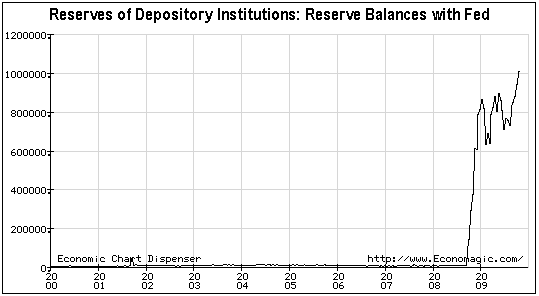|
|||
Bank Reserves and InflationSteve Saville Below is an excerpt from a commentary originally posted at www.speculative-investor.com on 29th October 2009. The following chart shows that bank reserves held at the Fed have increased 100-fold over the past 14 months -- from around $10B in August of 2008 to around $1000B ($1T) today. It is important to understand that while this explosion in the reserves of US depository institutions has rightfully prompted much discussion and consternation, it hasn't directly added to the total supply of US dollars (bank reserves are not counted in monetary aggregates such as M1, M2, M3, MZM and TMS). The reason that bank reserves aren't added to the money supply is that they do not constitute money available to be spent within the economy; rather, they constitute money that could be loaned into the economy or used to support additional bank lending in the future.
Bank lending in the US has declined on a year-over-year basis, so we know that the spectacular increase in reserves has not YET contributed to monetary inflation. Many analysts and economists view this as a problem, their belief being that the banking industry should support the economy by putting its excess reserves to work. To be more specific, they want the banks to lend more new money into existence on the basis that more debt is 'just what the doctor ordered' for an economy weighed down by the highest debt levels in history. Steve Saville Regular financial market forecasts and analyses are provided at our web site: We aren't offering a free trial subscription at this time, but free samples of our work (excerpts from our regular commentaries) can be viewed at: http://tsi-blog.com Saville Archives |

